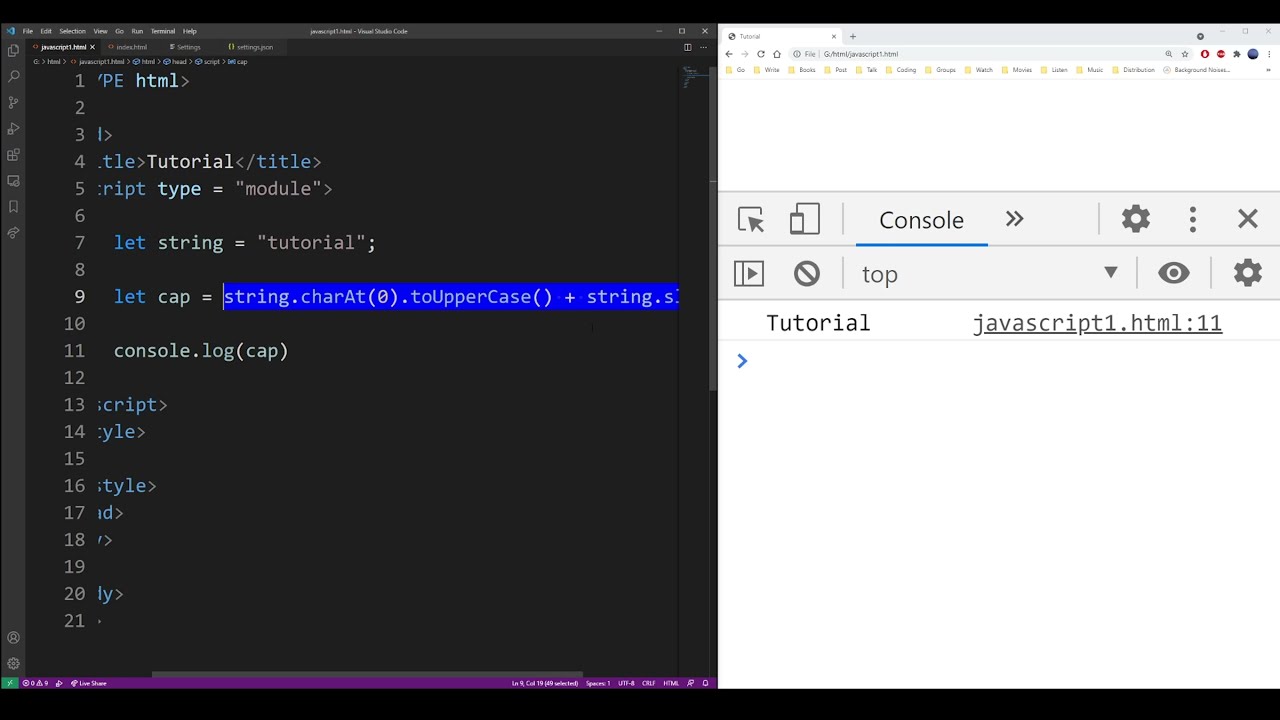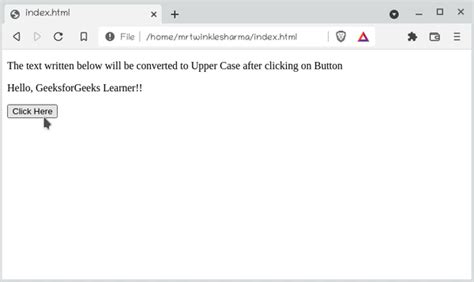3 Ways to Uppercase in JS

JavaScript is a versatile and widely-used programming language, and when it comes to manipulating text, one common task is converting strings to uppercase. In this article, we will explore three different methods to achieve uppercase conversion in JavaScript, providing you with a comprehensive understanding of the available options.
Method 1: Using the toUpperCase() Method

The toUpperCase() method is a built-in function in JavaScript that allows you to convert a string to uppercase characters. It is a simple and straightforward approach, making it the most commonly used method for uppercase conversion.
Here's how you can utilize the toUpperCase() method:
const originalString = "Hello, World!";
const uppercasedString = originalString.toUpperCase();
console.log(uppercasedString); // Output: "HELLO, WORLD!"
In the example above, we create a variable originalString containing a sample text. We then call the toUpperCase() method on this string, which returns a new string with all characters converted to uppercase. Finally, we log the result to the console.
It's important to note that the toUpperCase() method creates a new string and does not modify the original string. This ensures that the original string remains intact and avoids any unintended side effects.
Benefits of toUpperCase()
- Simplicity: The toUpperCase() method is easy to use and understand, making it accessible for developers of all skill levels.
- Wide Support: This method is supported by all modern browsers and JavaScript engines, ensuring compatibility across different environments.
- No External Dependencies: You don’t need to import any additional libraries or packages to use toUpperCase(), making it lightweight and efficient.
Considerations
While toUpperCase() is a convenient method, it’s worth considering a few points:
- Case Sensitivity: The method converts only lowercase letters to uppercase, leaving non-alphabetic characters and symbols unchanged.
- Performance: For large strings or performance-critical applications, repeated use of toUpperCase() might impact performance. In such cases, alternative methods can be more efficient.
Method 2: Using the split() and join() Methods

An alternative approach to converting a string to uppercase is by utilizing the split() and join() methods. These methods allow you to manipulate individual characters of a string, providing more flexibility in text manipulation.
Here's how you can use the split() and join() methods for uppercase conversion:
const originalString = "Hello, World!";
const uppercasedString = originalString.split("").map(char => char.toUpperCase()).join("");
console.log(uppercasedString); // Output: "HELLO, WORLD!"
In this example, we start by splitting the originalString into an array of individual characters using the split() method. We then use the map() function to iterate over each character and apply the toUpperCase() method to convert it to uppercase. Finally, we use the join() method to rejoin the characters into a single string.
Advantages of split() and join()
- Flexibility: This approach allows you to manipulate individual characters, enabling more complex text transformations.
- Customizable: By utilizing map(), you can apply additional logic or transformations to each character, making it highly customizable.
Disadvantages
- Performance Overhead: The split and join operations can be computationally expensive, especially for long strings. This method might not be the most efficient choice in performance-sensitive scenarios.
- Complexity: The use of split(), map(), and join() requires a deeper understanding of JavaScript’s array methods, making it less accessible for beginners.
Method 3: Using the toUpperCase() Function
If you prefer a more functional programming approach, you can create a custom toUpperCase() function that mimics the behavior of the built-in method. This allows you to encapsulate the logic and reuse it across your codebase.
Here's an example of how you can implement a custom toUpperCase() function:
function toUpperCase(str) {
return str.split("").map(char => char.toUpperCase()).join("");
}
const originalString = "Hello, World!";
const uppercasedString = toUpperCase(originalString);
console.log(uppercasedString); // Output: "HELLO, WORLD!"
In this example, we define a function toUpperCase() that takes a string as an argument. Inside the function, we use the split(), map(), and join() methods to convert the string to uppercase. By encapsulating this logic in a function, we can easily reuse it whenever needed.
Benefits of Custom toUpperCase()
- Modularity: Encapsulating the logic in a function promotes code reusability and maintainability.
- Extensibility: You can further enhance the function by adding additional parameters or logic to handle special cases or custom requirements.
Drawbacks
- Redundancy: Creating a custom function may introduce unnecessary complexity if the built-in toUpperCase() method suffices for your use case.
- Performance Impact: Similar to the split() and join() approach, custom functions can impact performance, especially when dealing with large strings.
Choosing the Right Method
When deciding which method to use for uppercase conversion in JavaScript, consider the following factors:
- Simplicity vs. Flexibility: If you need a straightforward solution, the built-in toUpperCase() method is the simplest choice. However, if you require more control over individual characters or need to apply custom transformations, the split() and join() approach or a custom function might be more suitable.
- Performance: For performance-critical applications, avoid excessive string manipulation. The built-in toUpperCase() method is generally more efficient than the split() and join() approach or custom functions.
- Code Readability: Choose the method that best aligns with your coding style and the readability of your codebase. The built-in toUpperCase() method is concise and easy to understand, while the split() and join() approach or custom functions offer more flexibility but may require additional explanations for clarity.
Conclusion

In this article, we explored three methods for converting strings to uppercase in JavaScript: the built-in toUpperCase() method, the split() and join() approach, and a custom toUpperCase() function. Each method has its strengths and weaknesses, and the choice depends on your specific requirements, performance considerations, and coding preferences.
By understanding these methods, you can make informed decisions and choose the most appropriate approach for uppercase conversion in your JavaScript projects.
Is the toUpperCase() method case-sensitive?
+Yes, the toUpperCase() method is case-sensitive. It only converts lowercase letters to uppercase, leaving non-alphabetic characters and symbols unchanged.
Can I use the toUpperCase() method for multiple strings at once?
+Yes, you can apply the toUpperCase() method to multiple strings by iterating over an array of strings or using array methods like map() or forEach().
Is there a way to convert a string to lowercase using JavaScript?
+Absolutely! JavaScript provides a similar method called toLowerCase() which works similarly to toUpperCase(), converting uppercase letters to lowercase.


